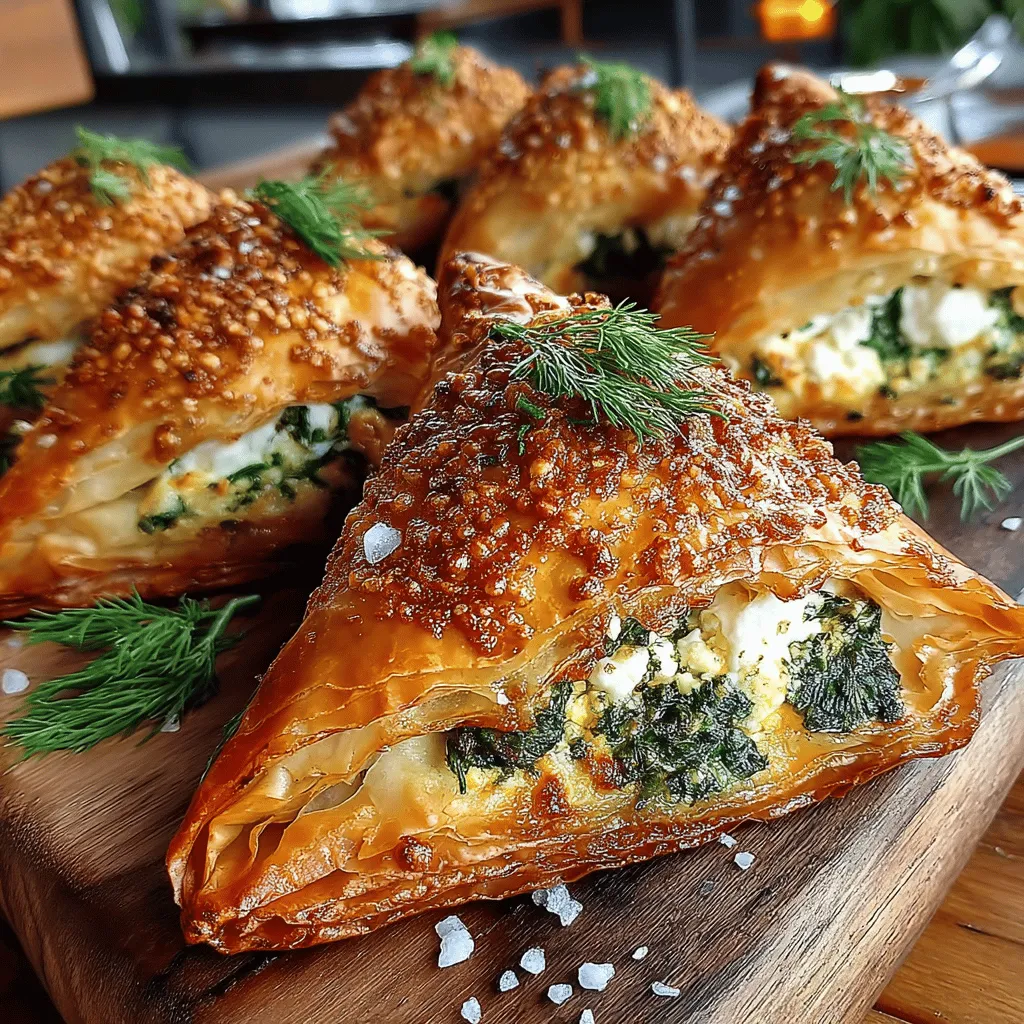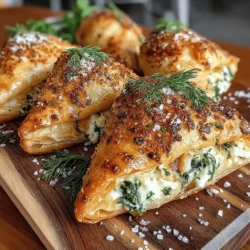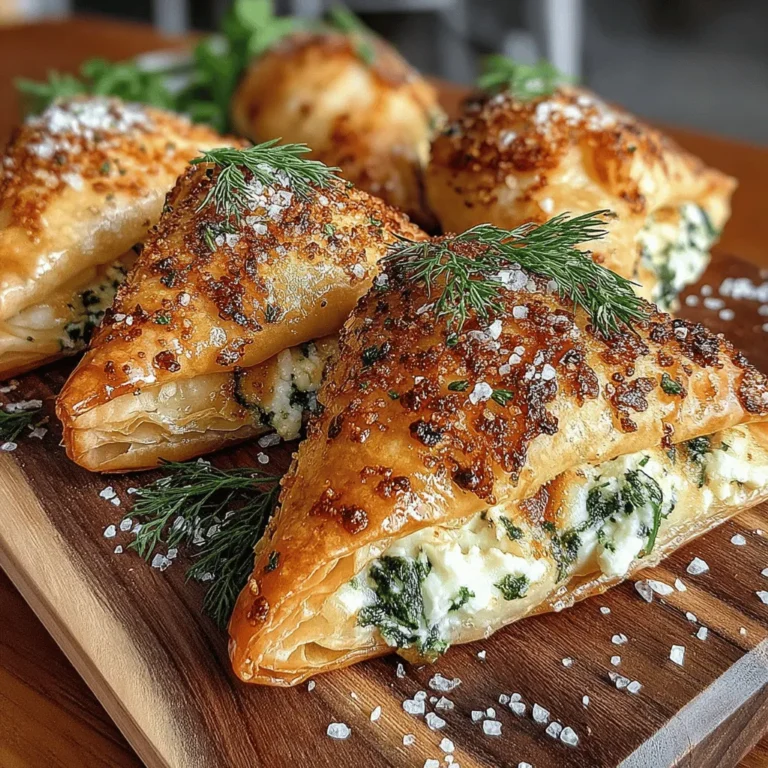Introduction
Greek cuisine is a vibrant tapestry of flavors, colors, and textures that reflects the rich history and culture of Greece. Among its many culinary treasures, spanakopita stands out as an emblematic dish, weaving together the earthy essence of greens and the creaminess of cheese into a delightful pastry. This iconic savory pie has captured the hearts of many, serving as both an appetizer and a main course at gatherings ranging from casual family dinners to grand celebrations. The Golden Spanakopita Triangles are particularly beloved for their enticingly flaky texture and rich, savory filling of spinach and feta, making them irresistible to anyone who tries them.
The allure of spanakopita goes beyond its delightful taste; it embodies the warmth and hospitality of Greek culture. Traditionally prepared in households across Greece, this dish has been passed down through generations, each family adding their unique touch and variations. Depending on the region, you might find different herbs or variations in the cheese used, making spanakopita a versatile dish that reflects local ingredients and preferences. Whether served as a festive treat during Easter or enjoyed as a quick snack on a busy weekday, spanakopita has a special place in the hearts of Greeks and culinary enthusiasts around the globe.
In this article, we invite you to embark on a culinary journey to create your own batch of Golden Spanakopita Triangles. We will explore the essential ingredients that make this dish so beloved, delve into the preparation of the filling, and master the techniques required to work with phyllo pastry. Get ready to bring the flavors of Greece into your kitchen!
The Allure of Spanakopita
Spanakopita has a rich history that dates back centuries, with its roots deeply embedded in Greek culinary traditions. The name itself translates to “spinach pie,” which succinctly captures the essence of the dish. Historically, spanakopita was a practical way for families to use fresh greens that were abundant in their gardens, especially during the spring months. The dish has evolved over time, but its core ingredients—spinach, cheese, and flaky pastry—have remained constant.
In Greece, spanakopita is not just a meal; it’s a symbol of community and celebration. Many families gather to prepare large batches for special occasions, sharing stories and laughter as they work together. The dish is often featured in festive feasts, weddings, and holiday celebrations, making it a cherished part of Greek heritage. Beyond the special occasions, spanakopita is also a popular choice for everyday meals, showcasing its versatility and appeal to all ages.
The variations of spanakopita across different regions of Greece add an exciting dimension to this dish. For instance, in Crete, you might find a version that includes a mix of wild greens, while in Macedonia, the addition of herbs like mint elevates the flavor profile. This regional diversity highlights how spanakopita can adapt to local ingredients and taste preferences, making it a dish that resonates with many.
Ingredients Highlight
The foundation of any great dish lies in its ingredients, and the Golden Spanakopita Triangles are no exception. Let’s take a closer look at the key components that contribute to the flavor and texture of this delightful recipe.
Fresh Spinach: The star of the filling, spinach is not only delicious but also packed with health benefits. Rich in vitamins A, C, and K, as well as iron and antioxidants, spinach is a powerhouse of nutrition. Its mild flavor allows it to blend seamlessly with other ingredients, making it the perfect green for our spanakopita.
Feta and Ricotta Cheese: These cheeses are essential for creating the creamy, savory filling that characterizes spanakopita. Feta adds a tangy, salty flavor that complements the earthiness of the spinach, while ricotta contributes a smooth texture that balances the mixture. Together, they create a harmonious filling that is both rich and satisfying.
Fresh Herbs: No Greek dish is complete without the fragrant touch of fresh herbs. Dill is a classic choice for spanakopita, imparting an aromatic quality that enhances the overall flavor. Other herbs, such as parsley or mint, can also be incorporated to add depth and complexity to the filling.
Phyllo Pastry: The secret to achieving that signature flaky texture lies in the use of phyllo pastry. This delicate dough is made from flour and water, rolled out into thin sheets that create layers of crispness when baked. Working with phyllo can be daunting, but with a few tips and tricks, anyone can master this versatile pastry and create beautiful Golden Spanakopita Triangles.
Preparing the Filling
Now that we’ve explored the key ingredients, it’s time to dive into the preparation of the filling for our Golden Spanakopita Triangles. The filling is where the magic happens, as the flavors meld together to create a delightful combination that will tantalize your taste buds.
1. Sautéing the Aromatics: Start by finely chopping some green onions and mincing a couple of cloves of garlic. In a large skillet, heat a drizzle of olive oil over medium heat. Add the green onions and garlic to the pan, sautéing them gently until they become fragrant and translucent. This step is crucial, as it creates a flavorful base for the filling. Be careful not to let the garlic burn, as this can impart a bitter taste to the dish.
2. Wilting the Spinach: Next, add the fresh spinach to the skillet. You may need to do this in batches, as the volume of spinach will initially seem overwhelming. Stir the spinach frequently until it wilts down, releasing its moisture. This step is essential to avoid excess liquid in your filling, which can make the pastry soggy. Once the spinach is fully wilted, remove the skillet from the heat and allow it to cool slightly.
3. Combining the Ingredients: In a mixing bowl, combine the sautéed spinach mixture with crumbled feta and ricotta cheese, along with a generous handful of chopped fresh dill. Season the mixture with salt and pepper to taste, but remember that feta is naturally salty, so adjust accordingly. Gently mix the ingredients together until well combined, ensuring that the flavors meld beautifully.
With the filling prepared, you’re one step closer to creating your Golden Spanakopita Triangles. In the next section, we will delve into the techniques for working with phyllo pastry, ensuring that your triangles turn out perfectly flaky and golden. Stay tuned as we continue to explore the art of making this beloved Greek dish!

Importance of Keeping Phyllo Sheets Covered
To ensure your Golden Spanakopita Triangles achieve the perfect texture, it’s crucial to keep the phyllo sheets covered while you work. Phyllo dough is notoriously delicate and can dry out quickly, leading to cracks and tears that compromise the final product. To prevent this, simply cover the stack of phyllo sheets with a slightly damp kitchen towel or plastic wrap as you layer and assemble your triangles. This small step not only preserves the moisture in the dough but also enhances the crispness of the final baked pastry.
Layering and Brushing Phyllo with Olive Oil
Now that you’ve prepared your workspace and covered the phyllo sheets, it’s time to begin the layering process. Here’s a step-by-step breakdown to ensure each layer is perfectly buttered, creating a deliciously flaky texture:
1. Prepare Your Workspace: Lay out your phyllo sheets on a clean surface. Keep your olive oil close at hand, as you’ll need it for brushing.
2. Layering: Take one sheet of phyllo and lay it flat on your surface. Using a pastry brush, gently brush the entire surface of the phyllo with olive oil. This oil is not only for flavor but also acts as a barrier to keep the layers separate and flaky.
3. Repeat the Process: Place another sheet of phyllo on top of the first and repeat the brushing process. Ideally, use about 3-4 sheets for each triangle to ensure they are sturdy enough to hold the filling.
4. Cutting into Strips: Once you have layered the phyllo, use a sharp knife or pizza cutter to slice the sheets into even strips, approximately 3-4 inches wide. This uniformity is essential for ensuring that your triangles bake evenly and maintain a consistent size.
Folding Techniques for Perfect Triangles
With your phyllo strips cut, it’s time to fold them around the flavorful spinach and feta filling. The folding process is not only artistic but also ensures that the filling is well-contained while baking.
1. Filling the Strips: Take one phyllo strip and place a spoonful of your spinach and feta mixture at one end of the strip. Be careful not to overfill, as this can lead to difficulty in sealing the triangles.
2. Folding: Start by folding the bottom corner of the strip over the filling to create a triangle shape. Press down gently to secure the filling within the fold.
3. Continuing the Fold: Continue folding the triangle over itself, working your way up the strip. Each fold should create a new triangle while enclosing the filling. As you fold, ensure that you’re keeping the edges aligned for a neat appearance.
4. Sealing the Edges: Once you reach the end of the strip, brush the final edge with a little olive oil. This will help seal the triangle and prevent it from opening up during baking. Ensure that all edges are securely pressed together.
Baking the Spanakopita
Now that your Golden Spanakopita Triangles are assembled, it’s time to bake them to perfection. The baking process is critical for achieving that coveted golden-brown finish.
1. Preheat the Oven: Preheat your oven to 375°F (190°C). Preheating is essential as it ensures that the triangles begin cooking immediately, which helps achieve a crisp texture.
2. Arrange on Baking Sheet: Line a baking sheet with parchment paper and arrange your triangles in a single layer. Make sure to leave some space between each triangle to allow for even heat circulation.
3. Optional Egg Wash: For an extra touch of elegance, consider brushing the tops of your triangles with an egg wash made from whisking one egg with a tablespoon of water. This step gives them a beautiful golden color and a glossy finish when baked.
4. Baking Time: Bake the spanakopita for about 25-30 minutes, or until they are golden brown and crispy. Keep an eye on them during the last few minutes to ensure they do not become overly browned.
Serving Suggestions
Golden Spanakopita Triangles are not only a delicious snack but also a versatile dish that can be served in various ways. Here are some delightful serving suggestions:
– Pair with Tzatziki Sauce: The cool, creamy texture of tzatziki complements the warm, flaky triangles perfectly. Serve the sauce on the side for dipping to enhance the flavors further.
– Accompany with Fresh Salad: A light Greek salad with cucumbers, tomatoes, olives, and feta cheese makes for a refreshing side that balances the richness of the spanakopita.
– Occasions: These triangles are ideal for various occasions, from casual family gatherings to elegant parties. They can be served as appetizers, snacks, or even as part of a larger spread.
– Portion Sizes: Depending on the event, consider serving two to three triangles per person for appetizers. If they’re part of a meal, one or two triangles may suffice, especially when paired with sides.
Nutritional Information
Golden Spanakopita Triangles not only delight the palate but also offer several nutritional benefits:
– Spinach: Rich in iron, vitamins A and C, and antioxidants, spinach contributes to overall health. It’s known for its anti-inflammatory properties and supports eye health.
– Feta Cheese: This cheese adds a source of protein and calcium, while its tangy flavor enhances the overall taste of the filling. Using reduced-fat feta can further decrease calorie content.
– Olive Oil: A staple in Mediterranean diets, olive oil is known for its heart-healthy fats. It provides essential fatty acids and is linked to various health benefits, including improved cholesterol levels.
– Balanced Diet: Each Golden Spanakopita Triangle can fit into a balanced diet, especially when paired with nutrient-rich sides. A serving size of two triangles can provide a satisfying snack or appetizer without overwhelming calorie counts.
Conclusion
Making Golden Spanakopita Triangles at home is a joyful culinary experience that brings the flavors of Greece into your kitchen. These flaky, savory pastries are not just delicious; they carry cultural significance and offer an opportunity to share traditional dishes with family and friends.
Embrace the process of creating these triangles as a celebration of culinary heritage. The satisfaction that comes from preparing and sharing spanakopita is unmatched, whether for a special occasion or a simple family dinner. By following this recipe, you not only contribute to your culinary repertoire but also indulge in a dish that is beloved across the globe. So gather your ingredients, roll up your sleeves, and start folding these delightful pastries—your taste buds will thank you!


